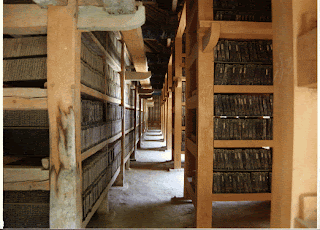 |
| at Haeinsa Temple, S. Korea |
How would you characterize your relationship to your writing? Stressful? Hopeful? Judgmental? When you sit down to write, do you greet the blank page with welcome or ambivalence? How about revering every word, every pause and edit, every hesitation and breakthrough, the rise of anticipation and its expression?
An aim of writing is to generate a flow, to tap into the verbal music that moves along on its own accord. Subject-verb-object. Words land on the page. The writing transports the writer deeper into herself, into the sea of language, into linking ideas, images, sound, and sense.
Challenge yourself. Trust the flow. Commit a few phrases to the page. Continue. Exile discouraging and judgmental thoughts. Keep going. Edits can take place later. Now is the time for creation, for the moment to moment listening and participating in the history and present incarnation of language.
Dive into the lingual morass. Feel the weight of words, your personal expression pressing into form, your words linking to an audience who engages with your writing, feels them, and considers their application.
Create a line. Your line.
I consider the process sacred. To write the self, to tell its stories, hear its wails and admissions, and watch its reflections and deflections, is to honor and know the self. How we string phrases together lays down the path to the wisdom and play of our imagination. It contributes to our individuality.
Yet another article about the future of books in the New York Times alarms me. Adam Davidson in “How Dead is the Book Business?” writes about the repercussions of the Penguin-Random House merger. He’s not optimisitic.
As the book business struggles, I worry that it means an increasing homogeneity of voices and little diversity in perspectives. I worry that there is less room for thought provoking work that feeds intelligence and that our nation is contracting from a dimming of intelligence and creativity. Content, variety and innovation loses to finance and popularity when audience size matters and manuscripts get published because they are predicted to garner the largest number of readers. How does one battle the Amazon Goliathan? Will books become a quaint, dusty item of the past sitting on grandma’s dresser?
We blog on.
Books are sacred. As a writer and ardent reader, I readily admit my bias. In my hands, my body settled on the couch, books — not digital ones, by the way — unleash my imagination and show me worlds no airline has taken me and ideas birthed in the mind of another. My attention shifts. I reach beyond the confines of my couch.
While writing this blog, I am reminded of Haeinsa Temple, a sacred site near the university where I taught in S. Korea. This Buddhist temple from the 8th century houses the Tripitaka, over 80,000 carved wooden slabs containing the Buddhist literary canon, specially preserved to withstand decay from wind and moisture. I would have liked to have read a few passages, however, the stories and commentaries are written with hanja (Chinese characters once used in Korean texts), and only monks are allowed to handle the texts. The closest I got was peering through the slit walls housing these texts and imagining the script. I dreamt that night about having access to the texts, placing a few slabs on my kitchen table, the words lifting off their blocks and penetrating my skin.
 |
| Tripitaka |
Within each of us is a voice yearning for expression. Close your eyes and settle into the quiet of your body to welcome the surfacing of that voice. Get out of your way. Set aside limiting thoughts and engage the source within that awaits your attention. Greet with welcome its phrases, its catches and tugs, the fits, starts, and eventual flow.
Haeinsa Temple reminds me to treat writing with reverence.
Write in the language you understand, the one that gives you complete access.
Remember, also, to buy a book.


